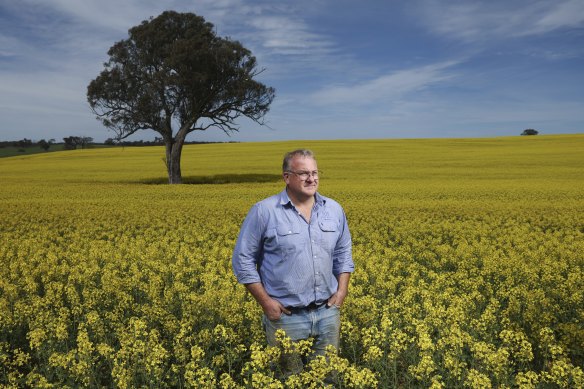By Mike Foley
Spring is in the air, the annual grain harvest is rolling down from Queensland, through NSW into Victoria, and the prospects for farmers and their radiant fields of blossoming canola are taking flight.
Once grown almost exclusively for cooking oil, canola is now in hot demand as a source of biofuel. Global biofuel production is forecast to quadruple by 2030, driven largely by demand for clean alternatives for aviation and diesel used in heavy haulage transport.

Sam Kelly surveys the canola crop at his Red Hill property at Bowning, NSW.Credit: Alex Ellinghausen
But farmer Sam Kelly, of Bowning in NSW’s southern tablelands, is far more concerned with the immediate prospects of the weather and what it could do to the 300 hectares he has under crop.
“It’s very nerve-racking,” Kelly says, as he sweats on an approaching cold front that could deliver a crucial drop of rain that would boost the health of his canola, improve his yield and significantly boost the price for his harvest.
Kelly is also nervously watching the weather for late-season frost, which he has luckily dodged – so far. A huge frost from South Australia’s Riverland, through Victoria and into southern NSW in mid-September – the largest area affected by a frost in a decade – downgraded winter crop values and wiped out wine grapes.
“There’s a huge amount of production risk. It’s a very difficult thing,” he said.
Kelly is optimistic about the prospects of growing demand for canola but, like any business owner, he is wary of the hype around new growth markets, pointing to international competition from agricultural export powerhouses in South and North America.
“There’s definitely a big potential, but you have to put it into perspective. We are [in Australia] competing with corn and soybeans,” Kelly said.
“Between Australia and Canada, we have big production of canola, but when you look at the United States and South America – if their seasons come together in a good way, they can have huge production.”
Australia on average grows about 5 million tonnes of canola every year, of which 3 million tonnes is exported. Each year 75 per cent of Australia’s canola exports are turned into biofuel in Europe, where demand is hot from corporations seeking green alternatives to traditional fossil fuel energy to meet their climate change commitments. Qantas, for example, has pledged to reach net zero emissions by 2050.
Biofuel is produced from biological sources like canola, soybeans or even algae. It is classified as carbon-neutral because although burning biofuel releases carbon emissions, growing trees to bear oilseeds sucks in carbon from the atmosphere.
Running machinery on biofuel is typically far more expensive than batteries powered by electricity, but there are no near-term prospects to electrify passenger planes or heavy machines like those used in mining.
That’s why Australian grain marketing company Graincorp has signed a memorandum of understanding with Ampol and global infrastructure fund IFM Investors to develop biofuel production in Australia.
Rural lender Rabobank Australia said the prospects for Australian canola and cottonseed – a byproduct of the fibre – are rosy.
“Canola and cottonseed can only meet a small portion of Australia’s future sustainable aviation fuel demand,” Rabobank’s February research report said.
“Ten per cent of Australia’s canola and cottonseed production could produce about 2 per cent of Australia’s sustainable aviation fuel demand by 2050. Even if the entire harvest of these crops were used, only 20 per cent of the total demand would be met.”
Big miner Rio Tinto has launched a pilot project to develop biofuels for its diesel-powered machines. It has bought 3000 hectares of land near Townsville, in Queensland, where it will plant 750,000 pongamia trees - a drought-tolerant plant native to south-east Asia that bears oil-rich seeds.
Cut through the noise of federal politics with news, views and expert analysis. Subscribers can sign up to our weekly Inside Politics newsletter.